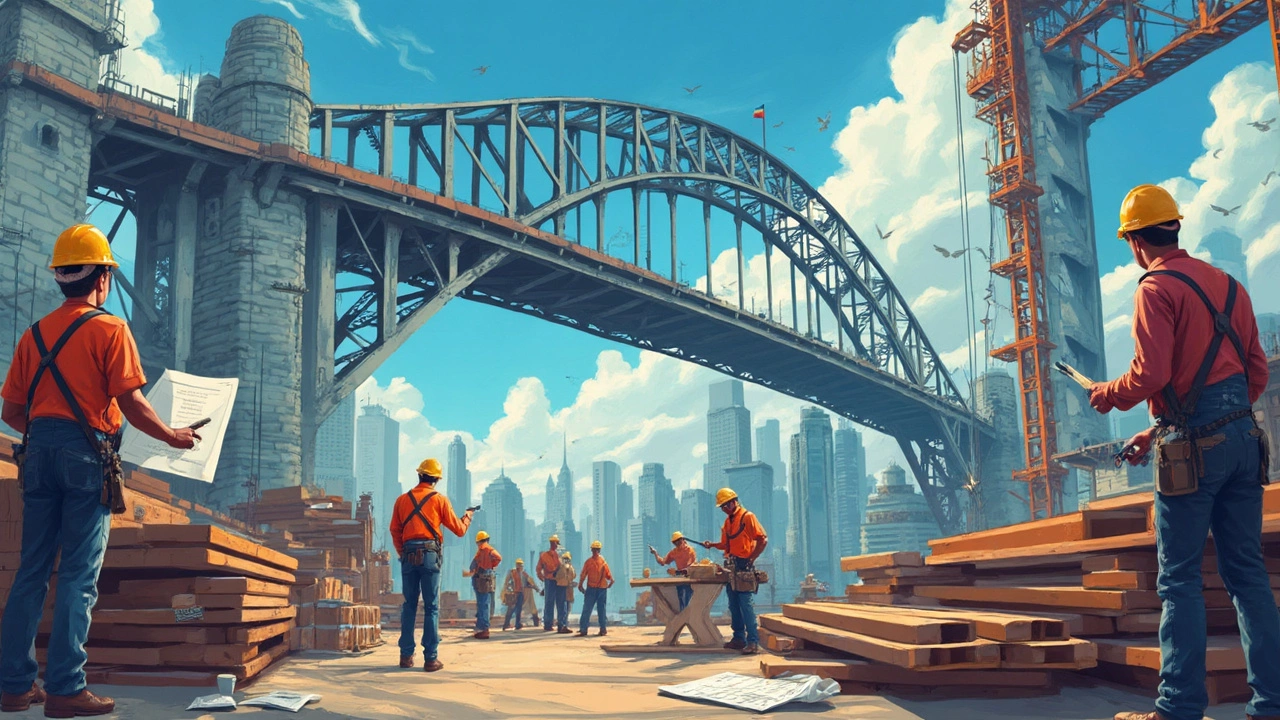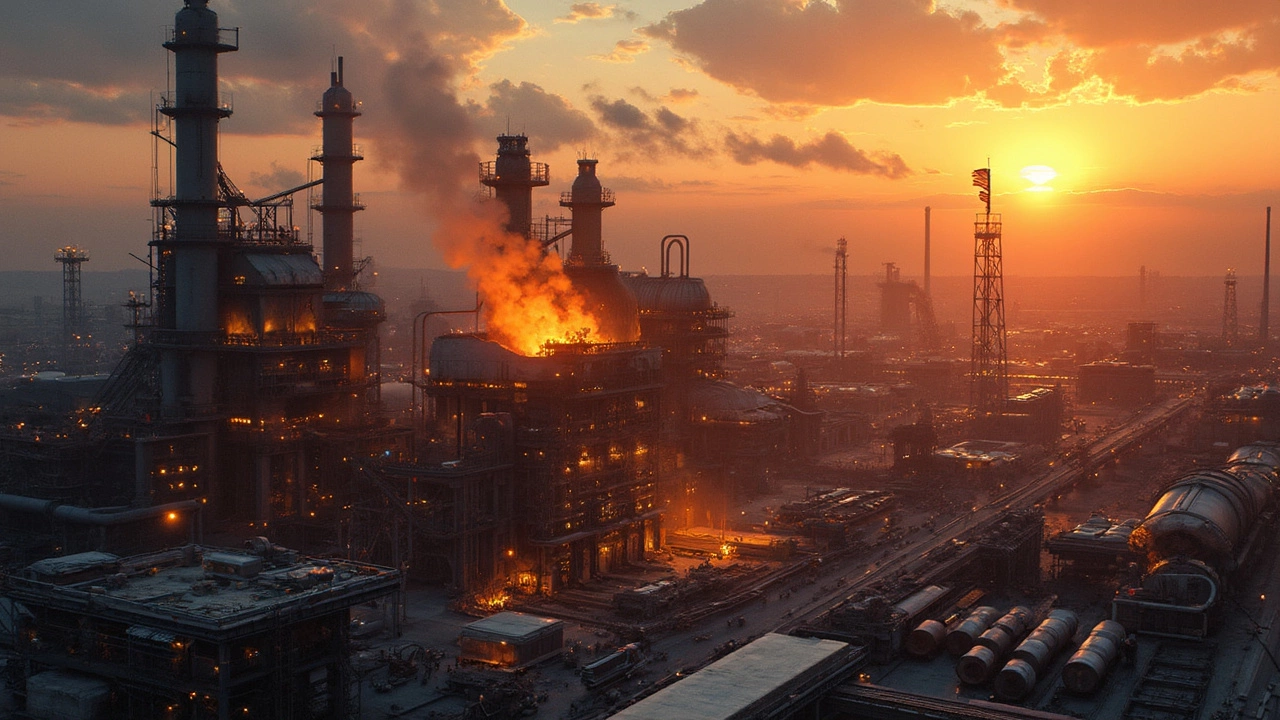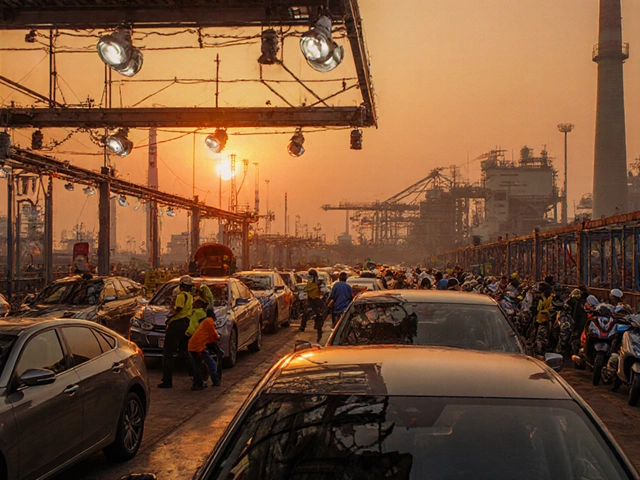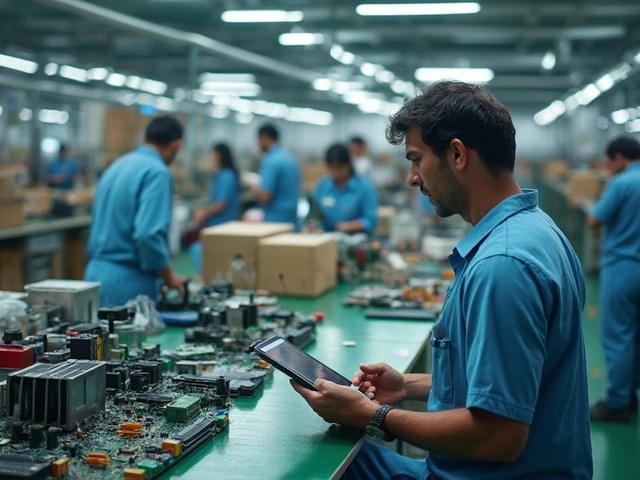If you walk by a skyscraper, cross a bridge, or just drive through a city in the US, you’re seeing the work of steel giants. But who’s at the very top of this game? Hands down, it’s Nucor. They produce more steel than anyone else in the country—think over 20 million tons a year. That’s not just a big number. It means they play a part in cars, appliances, schools, and even your local grocery store's roof.
This isn’t just trivia for industrial buffs. If you’re running a construction company, managing supply chains, or just working on a home project, knowing the big fish helps. Nucor sets trends, controls a chunk of pricing, and often leads on things like recycled steel—which, by the way, now forms nearly all their production. That’s good for your conscience and often, your pocket.
- The US Steel Industry Snapshot
- Meet the Biggest Player: Nucor
- Why Nucor Leads the Pack
- How Their Steel Shapes Daily Life
- Tips for Navigating the Steel Market
The US Steel Industry Snapshot
Steel is in almost everything Americans rely on daily, from buildings and cars to household gadgets. The US steel market is huge—think around $110 billion every year. Last year, US steel mills cranked out about 87 million metric tons of finished steel, putting the US as the fourth-largest producer globally. For some perspective, about 143,000 people work directly in steelmaking and manufacturing plants in the States.
The *largest steel supplier*—which you'll learn more about soon—is a massive player. But it’s not just the big names that matter. There are over 100 steelmaking and processing plants spread across the country, ranging from tiny specialty shops to major powerhouses. Most steel today comes from “mini mills,” which melt down scrap instead of using fresh iron ore. This means steel production is getting cleaner—right now, more than 70% of US steel gets made from recycled metal.
- About 80% of US steel stays inside the country for construction, cars, and machinery.
- Exports are solid too—Canada and Mexico grab the biggest chunk.
- Recycled steel helps cut carbon emissions and makes the US steel market more competitive worldwide.
| Top 3 US Steel Producers (2024) | Production (million tons) |
|---|---|
| Nucor | 20.6 |
| U.S. Steel | 13.8 |
| Steel Dynamics | 11.5 |
If you're wondering where all this steel ends up, think new homes, roadways, and a ton of electrical appliances. Unlike in the past, imported steel is less dominant now, making American-made steel a major piece of the country’s backbone.
Meet the Biggest Player: Nucor
If you've ever wondered who's really calling the shots in the American steel industry, here's your answer: it's Nucor. They aren't some old-school company stuck in the past. Nucor is all about pushing the envelope, and that's why they're at the top. Just check the numbers—they're the largest steel supplier in the US by a long shot.
Nucor kicked off back in the 1960s and didn’t waste time changing the rules of steelmaking. Instead of those massive, traditional blast furnaces, they use electric arc furnaces. These are quicker, cheaper, and way better for the planet because they recycle scrap metal. By 2024, Nucor had 300+ locations and over 31,000 employees nationwide.
Here’s what sets Nucor apart:
- Leads in recycling—almost all their steel comes from scrap metal.
- Runs more mini-mills than anyone else in the country.
- Consistently lands on "best places to work" lists for their culture and profit-sharing.
- Serves every major steel market—from construction and automotive to energy and appliances.
Their headquarters are tucked away in Charlotte, North Carolina, but their reach covers the whole US. No matter what type of steel you need—rebar, beams, sheets, or special grades—Nucor probably makes it. They don’t just flood the market; they drive trends, pricing, and supply. The next time you see an update about the steel market, odds are it’s Nucor leading the news.
Here are a few standout stats to back up the hype:
| Fact | Nucor Details |
|---|---|
| US Market Share (2024) | Over 27% |
| Annual Steel Production | About 25 million tons |
| Employees Nationwide | 31,000+ |
| Number of Mills & Facilities | 300+ |
| Steel from Recycled Material | Nearly 100% |
If you need steel in the US, there’s a good chance it either started or finished its journey in a Nucor facility. It’s that simple.

Why Nucor Leads the Pack
So what gives Nucor its edge in the steel game? It’s not just about size, even though they’re the largest steel supplier in the country. Nucor’s real advantage comes from how they do things and the principles they stick to.
First off, their business model is different from the old-school steel mills. Nucor built most of its success on mini-mills, which use scrap metal and electric arc furnaces. This makes their operations way more flexible and cost-effective. If demand drops or goes up, they can tweak production fast—very different from the expensive, slow-moving old-style plants.
Here’s something else: Nucor leads in using recycled steel. Nearly all their products come from recycled scrap, which slashes their raw material costs and appeals to customers who care about sustainability. According to their own numbers, they've been recycling more steel than any other US company for years, sometimes more than 20 million tons a year.
Their management style also surprises a lot of folks. Nucor has a no-nonsense bonus system: if the mill runs well, everyone from top managers to the people on the floor gets rewarded. The CEO’s pay goes up and down depending on company profits, just like everyone else’s. This keeps people motivated and invested in what they’re making.
Growth is another key factor. Nucor doesn’t just sit back—they keep buying up smaller plants, upgrading old ones, and adding new lines like specialty steels and bar products. In the last few years, they dropped billions into new facilities, especially in high-demand southern states. So when construction or auto manufacturing needs steel, Nucor is ready.
All these choices mean Nucor usually stays profitable, even when other steel companies are struggling. Their focus on efficiency, smart expansion, and green practices isn’t just good PR. It’s why their steel shows up in so many buildings, roads, and products across the country.
How Their Steel Shapes Daily Life
Steel from Nucor shows up in more places than most folks realize. Step inside a school, look up at a stadium's beams, or park inside a new garage—there’s a good shot the support structure comes from Nucor’s mills. Their steel isn’t just in huge bridges and skyscrapers, but also in train tracks, shipping containers, and even the shelves at your favorite big box store.
What’s wild is just how much of daily life gets covered by this company. According to 2024 data, Nucor’s steel products helped build over 35,000 bridges and 150,000 miles of rail lines in the US. They've even supplied steel for household appliances, making their way into your fridge or washer. Their rebar helps anchor highways, so your drive to work depends on their output more than you’d think.
The reason their steel is everywhere? They make just about every kind: beams, bars, sheets, plates, and steel used for auto parts. Here’s a quick look at how much Nucor touches different facets of American life:
| Product Type | Common Uses | Annual Output (2024) |
|---|---|---|
| Structural Beams | Buildings, stadiums, warehouses | 8 million tons |
| Rebar | Roads, bridges, parking decks | 3.2 million tons |
| Sheet Steel | Appliances, cars, roofing | 7 million tons |
| Steel Plate | Ships, heavy machinery | 2.5 million tons |
So, whether you realize it or not, the largest steel supplier in the US has a hand in almost everything sturdy you see or touch. As cities grow and infrastructure ages, Nucor’s role just keeps getting bigger. If you’re planning a project or buying steel parts, knowing their reach can help you understand supply, quality, and even why some prices move up—or hold steady—when the market gets tricky.

Tips for Navigating the Steel Market
If you haven’t shopped for steel lately, you might be surprised how fast prices and supply can change. Even the largest steel supplier in the US, Nucor, faces ups and downs from global demand, tariffs, shipping hiccups, and raw material costs. Being smart about your steel approach can save you cash and headaches.
- Watch price trends: Nucor and others usually move their prices every month based on scrap costs and demand. Check out industry indexes like Scrap Price Bulletin or the American Metal Market to see what’s up and what’s coming.
- Plan for lead times: Steel isn’t always sitting in a warehouse, ready to roll. Average lead times for structural shapes or rebar can run 4 to 8 weeks, but it gets longer when demand spikes. Build some buffer room into your timelines.
- Build relationships: If you buy a lot, don’t treat steel like it’s bread at the store. Get to know sales reps at the mills or service centers. Having a relationship can mean early heads-up on shortages, special pricing, or getting your order bumped up.
- Go recycled when you can: Nearly all of Nucor’s steel is made from scrap, which keeps the carbon footprint down. It can also sometimes be cheaper when scrap is abundant. Check with your supplier what types of recycled content they’re offering for your use case.
- Double-check grades and specs: Not all steel is created equal. Always verify what you’re buying matches local building codes or standards (ASTM, for example) to avoid surprises with inspectors.
Here’s a quick look at U.S. steel price swings just in the past few years:
| Year | Hot-Rolled Coil Steel Avg. Price (per ton) |
|---|---|
| 2021 | $1,700 |
| 2022 | $1,050 |
| 2023 | $950 |
| 2024 (so far) | $1,150 |
Bottom line? Stay up to date, keep your supplier close, and don’t wait until the last minute. The market moves fast, but with a little planning, you can stay ahead of curveballs — and maybe even snag a deal.






